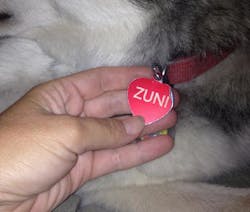Anyway, to the heart of the blog: I am impressed by the longevity of my laser-engraved pet ID tags that are now about four years old. The metal itself from which the tags were made has worn quite a bit, but the laser-engraved printing is still as crisp and readable as ever—including the fine print on the back side (see the heart-shaped tag on my malamute Zuni in the photo above).
If you haven't used one of these machines, I would definitely recommend giving it a try. And if you're a laser nerd like me, it's great to show your friends and family how these things work in an actual "commercial" setting—might make you seem less nerdy! Check out these YouTube videos for an idea of how the systems work (direct links to the videos are http://youtu.be/04zBbPhaGf4 and http://www.youtube.com/watch?v=Bi1fFaNuIjE).
Anyway, the videos are not nearly as exciting as going to the store and watching the sparks fly!
In researching these systems on the Internet, it's really quite amazing how much technology goes into the marking process. For example, I'm assuming the pet ID laser systems use carbon-dioxide (CO2) lasers and not neodymium:yttrium aluminum garnet (Nd:YAG or often shortened to just YAG) type lasers—especially considering that a CO2 laser system at around 40 W is about $2000 to $6000 dollars while a YAG system runs about $12000 to $25000 dollars (if Alibaba is any indication of competitive pricing).
I'm sure that Industrial Laser Solutions readers understand laser marking much better than I do, as I was surprised to learn that CO2 lasers are not meant for metal marking (I should know this, really; perhaps I need to read LFW once in a while rather than just write for it). In fact, the short web tutorial from Epilog laser systems (see http://www.epiloglaser.com/tl_yaginfo.htm) explains that the 1064 nm or 1.064 micron YAG wavelength is easily absorbed by most metals for good metal-marking characteristics, while many other materials like wood, acrylic, plastics, cloth, etc. cannot be easily marked with a YAG. Conversely, the 10.64 micron CO2 laser wavelength—ten times longer than the YAG wavelength—is ideally suited to marking materials other than metal. To mark metals using a CO2 laser, the metals are typically coated with a laser marking material (LMM) like CerMark or TherMark that is physically bonded to the metal by the heat of the laser creating a permanent black mark. The LMM market is indeed extensive; there is even a blog site devoted to all things CerMark-related; see http://lasermarkingmaterials.blogspot.com/.
So next time you head to one of those specialty stores to buy your pets a treat, check out the laser marking machine and make your pet a tag (I prefer the bone-shaped ones for male dogs and the heart-shaped ones for female dogs). They're worth the extra money and you can impress your loved ones with your extensive laser knowledge on the subject!


